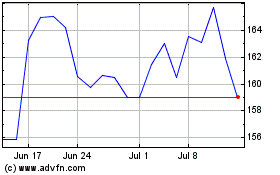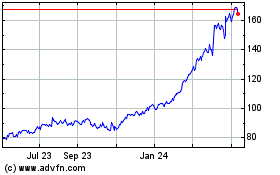By Dana Cimilluca, Dana Mattioli and Thomas Gryta
General Electric Co. is seeking a buyer for key parts of its
digital unit as the industrial conglomerate unwinds a signature
initiative of former Chief Executive Jeff Immelt.
The Boston-based company has hired an investment bank to run an
auction for the operations, which produced $500 million or more in
revenue last year and lost money, according to people familiar with
the matter. It isn't clear what exactly is for sale and how much a
deal could generate.
Though proceeds of a sale aren't expected to mean much for a
company with a market value of more than $100 billion, the move to
unload the operations is symbolic of a dramatic reversal of fortune
at GE, which has stumbled badly after a series of missteps.
GE Digital, a once highly touted software unit based in San
Ramon, Calif., was key to the strategic vision of Mr. Immelt, who
left last summer. As part of an effort to reorient itself away from
financial and media assets and bolster a sluggish stock price, the
company built a software platform called Predix that aimed to help
customers like utilities and airlines gather and analyze data to
better manage their equipment.
GE Digital was established as a stand-alone unit in 2015 to
distinguish it from the company's industrial divisions. Mr. Immelt
put a former Cisco Systems Inc. executive in charge and said his
goal was to make GE a top-10 software company by 2020.
In the fall of 2016, GE paid $915 million to acquire ServiceMax,
a Pleasanton, Calif., company that makes apps for inventory
management and workforce scheduling. Executives predicted at the
time that GE Digital would hit $15 billion in software sales by
2020 with half of that coming from providing Predix applications
for the electricity industry.
But the unit, which GE poured billions into, competes in an
increasingly crowded marketplace of companies offering digital
tools to control major industrial operations. Other competitors in
the field include cloud-software providers like Microsoft Corp.,
business-software makers like International Business Machines Corp.
and startups such as C3 IoT and Uptake Technologies Inc.
Since taking over for Mr. Immelt, GE's current CEO, John
Flannery, has scaled backed the mission for GE Digital. The company
has cut jobs in the division and said it planned to focus on
software for its existing customers and core businesses, rather
than catering to other industries. Mr. Flannery said earlier this
year that he expected revenue from Predix products would double
this year to about $1 billion and that he wanted GE Digital to
break even by 2020.
The company has said its digital business generated $4 billion
in revenue last year, up 12% from 2016. Not all of that activity
would go to a buyer as GE is expected to continue providing
software and services to its aviation and power customers.
While the process is at an early stage, possible buyers include
software companies and other industrial players seeking to become
more digital-focused, one of the people said.
GE's digital push included ramping up research spending and
hiring thousands of programmers to develop software for the massive
machinery it sells. In 2016, the company spent more than $4 billion
developing tools like analytics and machine-learning software. The
effort was also at the heart of the company's advertising, which
touted GE as a driver of a new "digital industrial" age.
Unlike most manufacturers, GE built its own operating system
from scratch rather than partner with a tech firm. It designed
software to crunch data from its jet engines and power turbines to
avoid outages and schedule maintenance, then set out to sell
similar tools to its customers and other manufacturers.
Trying to build out its own cloud infrastructure, essentially
replicating the expertise of companies like Amazon.com Inc. or
Microsoft, was challenging, said Chris Voce of Forrester
Research.
Running such a large-scale operation "both cheaply and
effectively is no small task," Mr. Voce said. "When trying to build
a software platform on the side, that's a tremendous
undertaking."
GE is now embarked on a companywide restructuring, sparked by a
precipitous decline in its shares last year that hasn't let up in
2018. The company said in June it would spin off its health-care
division and sell its ownership stake in oil-services company Baker
Hughes.
The two businesses, together with a railroad unit that is being
sold, accounted for a third of GE's $122 billion in revenue last
year. GE has said its yearlong portfolio review is complete and it
is essentially done with plans to sell $20 billion in assets.
Other industrial companies like Honeywell International Inc. and
Siemens AG, along with smaller firms, are using software to help
customers get more life out of heavy machinery -- while avoiding
unplanned outages -- by using complex data and models to predict
how the equipment will perform.
"It is imperative to have some kind of differentiated digital
industrial strategy and capability," said UBS analyst Steve
Winoker. It both helps sell the equipment and brings in lucrative
recurring revenue that comes from maintenance and service.
But at GE, "the hype engine went faster than their ability to
deliver," he said. "The first priority should be using the software
to help drive your own sales."
--Steven Norton contributed to this article.
Write to Dana Cimilluca at dana.cimilluca@wsj.com, Dana Mattioli
at dana.mattioli@wsj.com and Thomas Gryta at
thomas.gryta@wsj.com
(END) Dow Jones Newswires
July 30, 2018 18:28 ET (22:28 GMT)
Copyright (c) 2018 Dow Jones & Company, Inc.
GE Aerospace (NYSE:GE)
Historical Stock Chart
From Mar 2024 to Apr 2024

GE Aerospace (NYSE:GE)
Historical Stock Chart
From Apr 2023 to Apr 2024
